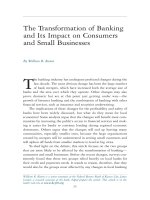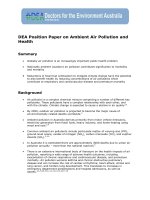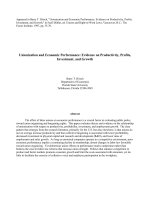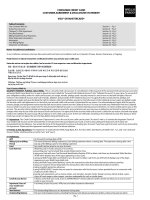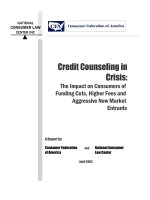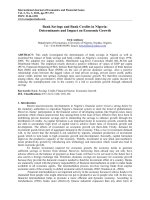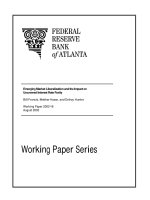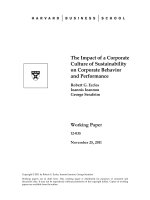Credit Reporting Customer Payment Data: Impact on Customer Payment Behavior and Furnisher Costs and Benefits doc
Bạn đang xem bản rút gọn của tài liệu. Xem và tải ngay bản đầy đủ của tài liệu tại đây (2.54 MB, 70 trang )
Credit Reporting Customer Payment Data:
Impact on Customer Payment Behavior and
Furnisher Costs and Benefits
By: Michael Turner, Ph.D., Robin Varghese, Ph.D., Patrick Walker, M.A. and Katrina Dusek, M.A.
Research Assistance: Adam Rodman
Results and solutions
March 2009
Copyright: © 2009 PERC Press. Chapel Hill, North Carolina. USA
All rights to the contents of this paper are held by the Political & Economic Research Council (PERC). No reproduction of this
report is permitted without prior express written consent of PERC. To request hardcopies, or rights of reproduction, please call:
+1 (919) 338-2798 x803.
March 2009
Credit Reporting Customer Payment Data
Impact on Customer Payment Behavior and
Furnisher Costs and Benefits
By: Michael Turner, Ph.D., Robin Varghese, Ph.D., Patrick Walker, M.A. and Katrina Dusek, M.A.
Research Assistance: Adam Rodman
Acknowledgements
e authors wish to thank the following people and organizations for their
contributions to and support of this study: Bob Ryan and Eric Rosenberg
of TransUnion; Tony Hadley, Debbie Morita, Donna Smith, Mike Hall
and Bill Butler of Experian; Clark Abrahams of SAS; Paul Mara, Paul
DeSaulniers and Steven Emmert of LexisNexis; Jennifer Tescher and Arjan
Schutte of CSFI; Gwendolyn Robinson and Windy Oliver of GE; Carmen
Hearn of HSBC; Mark Birkhead and Gopi Tammana of Citi; Walter
Wojciechowski of MicroBilt Corporation and Michael Nathans of the
PRBC division of MicroBilt; and e Brookings Institution. We also wish
to thank Julie Londo of DTE Energy and David Lukowicz of Nicor Gas for
allowing us to tell their companies’ stories to evidence the case for reporting
alternative data, and Jim Linn of the American Gas Association and Becky
Harsh of Edison Electric Institute”.
Table of Contents
Executive Summary and Key Findings 6
I. Introduction 9
II. Business Case for Fully Reporting to
Bureaus 13
a. Broad issues for non-nancial full-le
reporters 13
b. Why non-nancial data providers need not fear
cream skimming/poaching 16
III. General Findings From the
Survey of Firms 17
a. What Data is Reported and to Whom? 17
I V. Survey Results by Companies that
Currently Report to a Bureau 19
a. Which Companies are Reporting and Why? 19
b. Overall Costs, Benets, and Satisfaction 22
c. e Benets 24
d. e Costs and Diculties 25
e. e role of Customer Communication 29
V. e Case of NICOR Gas 31
a. Why Do they Report? 31
b. Costs and Diculties 32
c. Customer Education and Communication 33
d. e Benets to the Company 33
e. External Benets to Consumer 34
f. Nicor Gas’ Legacy 34
VI. e Case of DTE ENERGY 35
a. e DTE Energy Story 35
b. Process and Costs 35
c. Diculties 36
d. Benets 36
e. Lessons Learned 39
VII. Companies that Do Not Report 40
VIII. Customer Survey 44
Awareness of Reporting 44
Bill Payment Priorities 46
Payment Reporting and Behavior Changes 47
Key Findings from Customer Survey 50
IX. Facts and Myths of Reporting 51
X. Road Ahead, How to Report 54
XI. Conclusion 58
Appendix A: Overview and Methodology
Data Furnisher Survey 60
a. Limitations 60
b. Types of Companies that Responded 61
Appendix B: Overview and Methodology of
Customer Survey 64
Credit Reporting Customer Payment Data: Impact on Customer Payment Behavior and Furnisher Costs and Benets
6
Executive Summary and Key Findings
is report examines the perceived and actual costs and benets of full-le credit reporting by nonnancial
service providers, such as telecommunications companies and utilities, and assesses its impact on customer
payment behavior. Full-le credit reporting sends both timely and late payment information to a consumer
credit bureau. PERC surveyed energy utility and telecommunications companies and more than 1,000 con-
sumers. On the basis of responses from 70 companies and more than 900 heads of household with primary
or joint responsibility for paying bills, and two case studies of large energy utility rms that report full-le
payment data, PERC draws the following conclusions:
1
An example of a cooperative is the National Consumer Telecom and Utilities, Exchange (NCTUE). e data in the NCTUE is used
help telecoms and utilities set deposit amounts and locate customers that have unpaid balances, among other uses. Data in FCRA-regulat-
ed consumer credit reporting databases, on the other hand, are part of consumers’ credit histories and can enter their credit scores.
Most customers did not even know that mort-
gages and auto loan payments were reported,
highlighting the importance of customer com-
munication for companies that decide to report
customer payments.
Data must be included in a credit le to fully »
motivate payment behavior changes: Simply
reporting payment data to a credit bureau is
insucient. Data furnishers must make sure
the data is included in an FCRA regulated con-
sumer credit database. A major bureau already
collects negative payment data from energy util-
ity and telecom rms, but uses it for non-credit
purposes. To fully motivate customers, the data
needs to be included in consumer credit les.
From the customers’ perspectives…
Customers conrm that credit reporting alters »
payment behavior: One-half of all consumers
surveyed indicated they would be more likely
to pay their nonnancial service obligation on
time—even during economic duress—if those
payments were fully reported to one or more
national credit bureaus and consumer reporting
agencies and impacted their credit scores.
Approximately 35 percent of respondents
indicated they would be much more likely to
pay on time, 15 percent would be more likely
to pay on time, while 45 percent would remain
unchanged.
Many customers are unaware of which of their »
obligations are reported: 44% of consumers
did not know if energy utility payments were
reported and only 28% thought they were not.
PERC March 2009
7
From the rms’ perspectives…
Firms that fully report see changed consumer »
payment behavior: Consistent with results from
the consumer survey, the survey of rms and the
two case studies reveal that customers are more
likely to pay on time when they are aware that
their personal credit standing will be aected by
their payment actions. As the DTE Energy case
study makes clear, customer payment behavior
will change only when they are aware that their
payments are being reported to credit bureaus.
For most, benets of credit reporting greatly ex- »
ceed costs: All rms that fully report customer
payment data say that the benets of reporting
are at least equal to the costs of reporting. Ap-
proximately 14 percent of respondents indicated
that benets were between two and ve times
greater than costs, 29 percent reported benets
were between ve and ten times greater than
costs, and 29 percent reported the benets
exceed costs by at least a multiple of ten.
Firms that credit report are overwhelmingly »
satised with experience: No respondents
were dissatised with their experience of credit
reporting. Approximately one-fourth were
“neutral or mixed” about their experience, and
approximately three-fourths were either “some-
what satised” or “very satised.”
Firms overestimate perceived costs of credit »
reporting: e primary reasons rms did not
credit-report were assumed technology (IT) and
customer service costs. Yet, among those rms
that actively credit-report, all indicated that IT
and customer service costs were either small
(between 5 and 15 percent of the IT or customer
service budget) or minimal or no costs (less than
5 percent of the IT or customer service budget).
Greatest perceived challenges involve so costs: »
When asked to rank the diculty of implemen-
tation issues, rms currently fully reporting to
one or more credit bureaus ranked “developing
internal policy” and “educating consumers” as
by far the two greatest challenges. ey rated
technological, legal, and regulatory issues as
moderate or relatively moderate challenges.
Customer communication is important to fully »
realizing benets: Among rms reporting equal
costs and benets, one-half did not communi-
cate with customers at all. e majority indicat-
ing that credit reporting benets were greater
than costs frequently communicated to their
customers in various ways, usually monthly in
a billing statement. As our consumer survey
makes clear, consumers are generally unaware
which industries report payments and, appar-
ently, they are unaware of payment reporting in
general. erefore, customer communication
is key to reaping the full benets of payment
reporting. Customers unaware of payment
reporting will not alter their behavior.
Credit Reporting Customer Payment Data: Impact on Customer Payment Behavior and Furnisher Costs and Benets
8
From the borrowers’ perspective…
Many customers become scoreable when »
payments are fully reported: DTE
Energy’s case study conrms that many of
that utility’s customers obtained a credit
le and/or became scoreable due to its fully
reporting of customer payments. 127,126
of its customers, or 6.2% of its accounts,
were able to be scored for the rst time
when reporting began. Of new utility
accounts opened the following year, an
additional 9,117 new customers gained
credit scores because of DTE’s full-le
reporting. Having a credit score is crucial
when accessing mainstream aordable
credit.
PERC March 2009
9
I. Introduction
How can consumers be encouraged to put their
utility and telecommunication bills at the top of
the payment pile? Bucking the trend of increasing
delinquency and write-os requires a multifaceted
strategy, ranging from expanded payment options
and opportunities to using agents, utility discon-
nections, and legal action. e foundation of any
new strategy, however, should be grounded in a
single solution—reporting both positive and nega-
tive payment data to credit bureaus and consumer
reporting agencies. By holding consumers account-
able for their actions, by rewarding positive pay-
ment behavior and noting delinquencies on credit
reports, utilities have signicantly limited slow
payment and uncollectible debts.
e rise in uncollectible consumer debt and
delinquencies is a major concern of utility and
telecommunication service companies. In 2004,
Chartwell reported that utility companies wrote
o $1.6 billion annually, an equivalent of about
$8 per customer.
2
Today, utilities continue to lose
leverage as utility disconnections rise in dozens
of states. New York has seen a 17 percent increase
in service disconnections, and Michigan has seen
a 22 percent increase, for example.
3
An October
2008 national survey of consumers conducted by
the Online Resources Corporation (ORC) re-
vealed that 9 percent of surveyed households were
more than 30 days late on a utility bill, up sharply
from an October 2007 survey.
4
Furthermore, 5
percent of those in the 2008 survey had had their
utilities shut o for nonpayment.
All indications are that the outlook for utility
collections in the near term will not improve
signicantly. e National Mortgage Bankers
Association reported record high delinquencies
and foreclosures for the third quarter of 2008. It
estimates that 10 percent of all mortgage loans are
one to three months delinquent or in foreclosure.
5
2
e original source for the amount written o is from proprietary research by Chartwell, Inc., from the report “Credit and Collections
in the Utility Industry 2004 .” (Chartwell, 2004), this gure was referenced by Peace CIS in the 2004 white paper “Utility Collections
Best Practices” available at />3
Associated Press Newswire, “In Bad Economy, Power Cutos Soar,” October 6, 2008.
4
Online Resources Corporation, “Short on Money, Will Your Customers Pay Your Bill?
Updated Survey of U.S. Households and Bills ey Pay.” (CITY: ORC, December 2008), available online at www.orcc.com.
5
National Mortgage Banker Association, “Delinquencies Increase, Foreclosure Starts Flat in Latest MBA National Delinquency Survey.”
Press Release, December 5, 2008. Available at />Credit Reporting Customer Payment Data: Impact on Customer Payment Behavior and Furnisher Costs and Benets
10
In addition, by February 2009, unemployment had
risen to a 25-year high of 8.1 percent, reecting a
loss of about 4.4 million jobs since January 2008.
6
Faced with rising economic pressures, more
households are forced to prioritize bills for pay-
ment. A recent study by Experian, one of the three
large national credit bureaus, nds that consum-
ers tend to choose to be late on some obligations
and not on others rather than being late on all.
7
e study was based on 3.2 million credit records
that also had payments reported by telecommu-
nications, energy utility, and cable companies. It
found mixed priorities between energy utility,
telecoms, cable, and other creditors. e study also
found that companies could inuence consum-
ers who had some capacity to pay non-prioritized
bills. In a direct comparison between bank card
obligations and utilities (including energy utility,
telecoms, and cable obligations), only 12 percent
of the four in ten consumers with derogatories on
either chose to be delinquent on both bank card
and utilities obligations; 32 percent chose to be
delinquent on their bankcard obligations alone,
and 56 percent chose to be delinquent on their
utility obligations alone. erefore, most chose to
prioritize one obligation over another, and most
chose to pay bank card obligations rst.
Experian’s ndings indicate up to 40 percent of
slow-paying utility and telecom consumers have no or
fewer than three derogatory accounts on their credit
report. Although these consumers have not been
paying their utility, telecoms, and cable bills, they
have remained relatively current on other obligations.
Clearly, consumers are making a choice not to pay
their utility or telephone bill on time while paying
other obligations rst.
e October 2008 ORC survey, along with two
earlier surveys by ORC, nds that customers placed
utilities in the middle of a ranking of bills they would
not pay if they lacked the funds to pay all of eight
types of bills. ey would pay loans, insurance, and
mortgages obligations before paying utilities, with
roughly 8.5 percent of consumers indicating that
they would not pay their utility bill. Phone bills were
essentially tied with credit cards as the obligation
least likely to be paid. Interestingly, between October
2007 and October 2008, the share indicating they
would choose not to pay their phone bill rose from ap-
proximately 20 percent to approximately 26 percent,
while the share choosing not to pay credit cards fell
from approximately 34 percent to approximately 27
percent. Consumers would most oen choose to pay
their mortgage, with only approximately 2 percent of
consumers indicating they would not pay their mort-
gage if they experienced cash ow problems
8
.
6
Bureau of Labor Statistics, “Employment, Hours, and Earnings from the Current Employment Statistics survey (National).” Databases,
Tables, and Calculators tool. (Washington, DC: BLS, 2009), available at />tool=latest_numbers&series_id=CES0000000001&output_view=net_1mth.
7
Experian, “Consumer Payment Behavior toward Telecommunications, Energy, and Cable Credit Grantors.” White paper. Available at
/>8
Online Resources Corporation, “Short on Money, Will Your Customers Pay Your Bill?
Updated Survey of U.S. Households and Bills ey Pay.” (ORC, December 2008), available online at www.orcc.com.
PERC March 2009
11
Consumers clearly prioritize payments when their
budgets are tight. Being able to inuence this
choice can have a meaningful eect on a rm’s
cash ow and bottom line, particularly when the
economy is weak. To better understand the degree
to which full-le payment reporting can inuence
consumers’ payment decisions, we conducted a
survey of more than 900 consumers with primary
or joint bill-paying responsibilities. e results
indicate that full-le payment reporting can
inuence whether a consumer pays on time, with
roughly 50 percent indicting they would be “more
likely” or “much more likely” likely to pay on
time if they knew their payment behavior would
inuence their credit score.
To gauge the costs and benets of payment
reporting from the rm side, we conducted a
survey of 70 utility and telecommunications
companies. (For details, see Appendix A.) We
found that full-le credit reporting (reporting
that includes both positive and negative
information) requires low upfront costs with
limited technological (IT) modications. Full-le
reporting can have signicant and long-lasting
eects in payment activity for a large proportion
of a company’s customer base. At the same time,
benets accrue to the consumer, particularly
those outside the credit mainstream.
9
us,
both nonnancial data furnishers (utilities and
telecommunications companies) and consumers
benet from full-le reporting.
We also include two case studies (Nicor Gas
and DTE Energy) to showcase the experiences
of moving from no payment reporting to fully
reporting to one or more credit bureaus. Finally,
we include basic facts of reporting to consumer-
reporting agencies, as well as useful information
for those considering reporting.
9
Turner, Michael, et al., Give Credit Where Credit is Due: Increasing Access to Aordable Mainstream Credit Using Alternative Data.
(Washington, DC: PERC and Brookings Institution Urban Markets Initiative (UMI), 2006, available at />les/downloads/alt_data.pdf.
Credit Reporting Customer Payment Data: Impact on Customer Payment Behavior and Furnisher Costs and Benets
12
Section 2 makes the business case for
nonnancial rms to fully report customer
payment data to credit bureaus and consumer
reporting agencies, a practice commonly
referred to as “credit reporting.” We present
variables for executives to consider when con-
ducting internal cost-benet analyses, includ-
ing potential competitive concerns.
Section 3 presents general ndings from
our survey of utility and telecommunications
rms, with a focus on what data is and is not
reported to credit bureaus.
Section 4 explores survey results for those
rms that are currently credit reporting. We
examine perceived versus actual costs and
benets and explore how satised rms are
with their credit reporting experience.
Sections 5 and 6 present two case studies
from two energy utility companies—Nicor
Gas and DTE Energy. ese case stud-
ies focus on specic experiences of internal
decision-making, customer communications,
relations with regulators, public relations,
implementation processes, and implementa-
tion costs and benets.
Section 7 examines the survey results from
those rms that do not report, including
factors preventing them from reporting and
reasons they are considering reporting.
Section 8 reports the results of a survey
of more than 900 heads of household with
primary or joint bill payment responsibili-
ties (customers). e survey gauges customer
understanding of payment reporting and
likely responses if obligations they paid were
fully reported.
Section 9 addresses some widely perceived
myths about credit reporting.
Section 10 discusses steps that energy util-
ity and telecommunications rms may take
should they decide to credit report.
Section 11 oers a summary and conclud-
ing thoughts on credit reporting.
e report proceeds as follows:
PERC March 2009
13
II. Business Case for Fully
Reporting to Bureaus
a. Broad issues for non-nancial full-le
reporters
Energy utility and telecommunications rms
considering credit reporting must rst undergo
some basic cost/benet analysis before coming to a
decision about whether to proceed. Below are some
variables that must be factored into such analysis:
Costs:
IT Systems—Firms with national or regional
footprints, especially those that have grown
through mergers and acquisitions, need to explore
the potential outlays associated with regularly
reporting customer payment behavior to one or
more credit bureaus or consumer reporting agen-
cies. In a small number of cases, owing to struc-
tural dierences in billing systems and dierences
in billing cycles among units within a single rm,
regular credit reporting of all customer payment
data is problematic and requires expensive IT
upgrades. In most cases, however, billing systems
can easily handle regular credit reporting in the
industry Metro2 format, and data verication/
reverication in the eOscar system. Other IT costs
may include data hygiene, programming, and data
storage, as records will need to be archived for up
to seven years.
Customer Service—Making the decision to
credit report requires a rm to comply with cer-
tain data furnisher obligations as specied in the
Fair Credit Reporting Act (FCRA).
10
In general,
the act species data furnisher requirements
regarding how information is shared with credit
bureaus and consumer reporting agencies, condi-
tions under which notications are to be provided
to data subjects, responsibilities in the event of ac-
tual or suspected ID the, and responsibilities in
cases of adverse actions or disputed information.
All of these activities require person hours from
designated customer service sta. And while many
larger rms may absorb this simply by investing
in additional training for existing personnel given
excess capacity, some smaller rms may need to
actually add customer service capacity to comply
with FCRA data furnisher obligations.
10
Fair Credit Reporting Act. 15 U.S.C. § 1681. See in particular § 623 “Responsibilities of furnishers of information to consumer
reporting agencies.”
Credit Reporting Customer Payment Data: Impact on Customer Payment Behavior and Furnisher Costs and Benets
14
Litigation—Currently, data furnishers found to
be in willful or negligent non-compliance with
the terms of the FCRA potentially face both civil
liability and administrative enforcement actions.
Fines for noncompliance range up to $1,000 to
$2,500 per violation, plus any punitive damages
that the court may allow. While reporting
has the effect of increasing a data furnisher’s
exposure to litigation, actual instances of
successful civil litigation and enforcement actions
against furnishers are quite rare. Nonetheless, it
is a factor that should be considered.
Internal Communications—Firms that decide
to credit report will need to invest resources in
both internal and external communications.
Internally, a team of relevant executives will need
to be assembled and responsibility assigned to
ensure full buy-in initially, and ongoing support
once the process of credit reporting has begun.
Internal education of executive and staff teams
about the benefits of credit reporting to the firm
and the consumer relative to cost can further
align internal divisions to execute. It is likely
that there will be difficult periods—potential
troubles with IT, legal concerns, customer
backlash, negative publicity—and the staff
responsible for the execution of a credit reporting
program must have the support of senior
management to quickly and adequately respond
to and resolve problems as they arise.
External Communications—Similarly, resources
must be committed to external communications
with regulators, the media, and most importantly
with customers. Scheduling meetings with the state
regulator (PSC or PUC) to discuss the decision to
credit report, and share relevant details—how the
rm will comply with the FCRA, planned cus-
tomer awareness campaigns, any customer friendly
provisions in the reporting plan (for example, not
reporting delinquencies under 60 days, and not
reporting small unpaid balances), and the customer
benets of reporting (as quantied in various PERC
and Brookings Institution studies), will go a long
way toward securing support or tolerance from the
regulator. Communications with area mainstream
media should also be part of the credit reporting
process, as external communications should have
collateral materials and op-ed pieces highlighting
the very real value that credit reporting will bring to
customers. Finally, in that credit reporting is funda-
mentally about changing customer behavior, regular
and ongoing communications with customers will
yield considerable dividends. is should go beyond
blurbs on monthly statements or statement stuers,
and should include public service announcements,
clever print, radio or TV ads, and potentially a series
of town-hall style meetings. It is as important, if not
more so, to discuss the benets of reporting linked to
timely payments. Collectively, these communications
eorts represent real costs. e bulk of these costs
will be front-loaded, but continued investments in
customer communications will be required for the
life of the program.
PERC March 2009
15
Harmonize Billing Exceptions, Extenuations,
and Special Forbearance Programs with Credit
Reporting Rules—Metro2 formatting possess
a signicant amount of exibility for the data
furnisher when determining when to classify an
account as delinquent, when to classify an account
as being in default or charging it o (e.g. setting
minimum balance requirements for derogatory
reporting, and allowing grace periods prior to re-
porting derogatory information). To maximize the
benets for the data furnisher, it is suggested that
industry reporting standards be adopted.
Benets:
Improved Cash Flow—Analysis of how people
prioritize payment obligations reveals that util-
ity bills rank between the middle to the bottom.
However, whenever a utility company engages in
credit reporting, the prioritization ranking climbs
dramatically. ese studies of personal behavior
are borne out by the experience of those pioneer-
ing rms that have already begun to fully report
customer payment data to one or more credit
bureaus.
A 2004 report issued by Nicor Gas and Tran-
sUnion indicates that a year aer Nicor began
their credit reporting program, delinquencies and
charge os were reduced by 20%. is number
improved during year two, and while delinquen-
cies and charge os have been trending upward as
of late, Nicor executives attribute this solely to a
downturn in the American business cycle, and not
to and reduced ecacy of credit reporting.
11
Nicor is not alone with this experience. During an
event hosted by the Brookings Institution Ur-
ban Markets Initiative in 2005, WE Energy and
Verizon each reported that the decision to credit
report had immediate and positive impacts on
their cash ow.
12
In fact, Verizon was so impressed
with the results of an early pilot involving fully
reporting landline customer payment data to a
single bureau, that within a several months they
ramped up their participation rate to over 20 mil-
lion landline accounts being reported regularly to
all three credit bureaus.
13
Increased Appeal—By allowing customers to be
rewarded for their on-time and sucient pay-
ments, and not just punished for their severe delin-
quencies, utilities and telecommunications rms
can oer added value to their customers. is add-
ed value should be communicated to the service
provider’s customers. It may be possible to note
on each statement, for instance, that it could be
the Xth on-time and sucient payment in a row
reported to credit bureaus or consumer reporting
agencies. Such creative ways can be used to align
the consumer’s interest in improving their credit
11
Interview with David Lukowitz, Manager of Customer Care Services and Credit, Nicor Gas, March 2008.
12
Statement by Marcia Johnston of Verizon at the “Roundtable on Using Alternative Data Sources in Credit Scoring: Challenges and
Opportunities,” Asset Builders of America and e Brookings Institution, December 15, 2005.
13
Op. cit.
Credit Reporting Customer Payment Data: Impact on Customer Payment Behavior and Furnisher Costs and Benets
16
prole with the data furnisher’s interest in receiv-
ing on-time and sucient payments. Additionally,
advertising that making on-time payments can
improve a person’s credit prole may also be an
eective approach to gaining new customers, and
particularly those who expect to pay on time.
Increased Customer Loyalty—e majority of
customers, and particularly the best customers
(those that consistently pay on-time), are likely to
be more loyal to the utilities or telecoms that are
reporting their payment information. Commu-
nicating the benets of full-le reporting should
be an eective way to increase customer loyalty
among these customers.
Goodwill with Regulators & Legislators—Com-
panies that plan to fully report should reach out
to regulators and legislators to explain that they
are going beyond the usual practice of reporting
only delinquencies or sending severely delinquent
accounts to collection agencies and will also be
reporting the on-time payments. With appropriate
customer friendly practices in place, regulators and
legislators should welcome this fairer, expanded
form of payment reporting. Legislators should
also welcome the increased access to credit and
the sounder credit that will be enabled with the
additional payment information included in credit
les, particularly for those consumers that are
credit underserved. is should be supplemented
with visible media and public relations eorts to
build community goodwill.
b. Why non-nancial data providers
need not fear cream skimming/
poaching
A common fear expressed by potential data
furnishers is that if they furnish the payment
history of their customers, their competitors
will essentially have access to a list of their best
customers and be able to aggressively market to
them. For some non-nancial companies that
do not face competition, such as energy utilities,
this, of course, is not an issue. For others, such
as telecommunications companies, this could be
a real fear. ere are, however, a few reasons why
companies need not fear this.
Following the Gramm-Leach-Bliley Act of 1999, it
is no longer possible to use general “credit header”
data, such as names and addresses for general mar-
keting lists. e only marketing that is permissi-
ble using credit le data are those that include rm
oers of credit or insurance.
14
For non-nancial
service providers, such as a mobile phone service
provider, this could include a rm oer of credit
for mobile phone service.
But in cases where marketing does occur (rm
oers of credit or insurance), the bureaus do not
provide lists of a competitor’s customers. So,
phone company A cannot acquire a list of phone
company B customers.
14
Section 604 of the Fair Credit Reporting Act (FCRA). http://www.c.gov/os/statutes/031224fcra.pdf.
PERC March 2009
17
And for companies that do report their customers’
payment data, they can inform their customers
that they are permitted by the FACT Act to indi-
vidually opt-out of marketing via their credit le.
is allows for the benets of increased access to
credit, a result of reported payment history, while
at the same time informing customers of their
right to opt-out of marketing.
III. General Findings From
the Survey of Firms
a. What Data is Reported
and to Whom?
Reporting practices of survey respondents varied
considerably. While some rms fully reported
payment data directly to a credit bureau, many
more report negative-only (either directly or indi-
rectly). Among those that believe they are report-
ing, many report to a cooperative database that
while used for account decisioning (e.g. whether
a candidate is eligible for an international wire-
less phone account, or whether an applicant must
secure their account with a deposit) is not included
in a person’s consumer credit le that is accessible
by nancial organizations.
15
In such reporting consumers do not enjoy the
benets or suer the consequences from having
their payment data reported to one or more of
their nationwide credit les. Instead, data is only
accessible by other members of the cooperative
database and is only used for determining plan
15
An example of such a database is the National Consumer Telecom and Utilities, Exchange (NCTUE) housed at Equifax.
Credit Reporting Customer Payment Data: Impact on Customer Payment Behavior and Furnisher Costs and Benets
18
eligibility and whether or not a security deposit
will be required. Still, others report late payments
and charge-o information to credit bureaus
indirectly through collection agencies. Around
22% (10/69) of respondents indicated that their
rms reported delinquencies and defaults to a
cooperative database.
A far greater share of respondents, 89% (62/70),
reported that their companies referred delinquen-
cies and defaults to collections agencies. And of
these, 73% (45/62) reported that they were aware
that these collection agencies then passed these
delinquencies and defaults on to one or more of
the national consumer credit bureaus, with an
additional 6% (4/62) indicating that they did not
know or did not answer this question. Hence, the
majority of the rms participating in the survey
indicate that they indirectly pass on negative
payment information (severe delinquencies and
defaults) to consumer credit bureaus.
As Figure 1 indicates, there is no set point at
which delinquencies are considered severe enough
to send to collections agencies. What is surprising
is that a few indicated that their rms sent ac-
counts to collections in cases in which the account
is less than 90 days past due.
3
16
10
3
8
12
7
0
2
4
6
8
10
12
14
16
18
< 90
Days
Past Due
90 Days
Past Due
120 Days
Past Due
150 Days
Past Due
180+
Days
Past Due
After
Account
Closed
Other
Number of Respondents
Figure 1: Reporting Behaviors of Surveyed Service Providers
Source: PERC 2008 Data Furnisher’s Survey Responses
PERC March 2009
19
e vast majority, 91% (64/70), of the rms
surveyed obtain credit reports or use third party
authentication services as part of the new account
opening process. Only 14% (10/69) of the compa-
nies surveyed reported that their companies cur-
rently reported payment information directly to a
credit bureau. And of these, 78% (7/9) reported
full le and 22% reported only negative payment
information.
In sum, the bulk of companies surveyed do not
report directly to consumer credit bureaus, but do
pass on delinquent accounts to collections, and do
use third-party data for processing new accounts.
IV. Survey Results by
Companies that Currently
Report to a Bureau
a. Which Companies are Reporting
and Why?
Of the ten companies that indicated that their com-
pany reported directly to a bureau, nine were energy
utility companies providing gas (4/9) electricity
(1/9) or both (4/9). One respondent indicated their
rm provided other services to homes and farms.
ree reported that their company serves less than
one million customers and seven reported that
their company serves between one and ten million
customers. ese companies serve all major regions
of the country.
e nine energy utility providers went on to answer
additional questions regarding details of the report-
ing and reporting experiences.
Again, most (7/9) reported full le (both positive
and negative account information) to a bureau,
with the two remaining companies supplying
only negative information to one or more of the
bureaus. However, this may be somewhat at odds
Credit Reporting Customer Payment Data: Impact on Customer Payment Behavior and Furnisher Costs and Benets
20
with utility data furnishers in general. A major bu-
reau reported to us that only about one-quarter of
their active utility data furnishers reported more
than only negative information.
Of the (2/9) rms that only report negative infor-
mation, one indicated that the top six incentives
shown in Table M, with the exception of the tax
incentives, would be strong incentives to induce a
move to full-le reporting. e exception of the
tax credit for IT investment may be due to the fact
that the rm is already reporting negative informa-
tion, and may have already made the necessary IT
upgrades. is dierence should be noted as it is
likely that a dierent set of motivations may be
optimal in encouraging rms to switch to full-le
reporting from negative-only compared to those
encouraging rms to move to full-le reporting
from no reporting. at is, those rms that provide
negative-only information would be interested only
in the costs and benets associated from the switch
from negative-only to full-le reporting.
While a sample size of seven full-le data furnishers
may not be that large, it should be noted that one of
the underlying reasons for this survey is that so few
utilities and telecoms fully report. In discussions
with various personnel at the major credit bureaus,
utilities, and telecoms, evidence suggests that the
universe of sizeable utility and telecom rms that
are actively furnishing full-le data is not much
greater than 15 or so. As a result, our survey likely
captures approximately half of the total popula-
tion of energy utility and telecom rms that fully
report customer payment data to one or more credit
bureaus. e results, therefore, are telling.
Factor Percentage
To reduce delinquencies, improve promptness of payments 100%
Consumer reporting agencies asked us to
11%
To build brand and a competitive advantage by helping customers build credit
11%
Other (1 response: “To help customers build credit”)
11%
My company was consolidated with another company that does so
0%
Table A: Factors in Deciding to Report
Source: PERC 2008 Data Furnisher’s Survey Responses
PERC March 2009
21
e respondents reported whether each of the fol-
lowing was a factor in deciding to report payment
information to a bureau.
As seen in Table A, the overwhelming objective
from these companies appears to be improvement
of the bottom line, improved cash ow and the
improvements resulting from the reduction of
delinquencies and charge-os.
And when asked how long their company had
been reporting payment information to a bureau,
the following responses were returned:
To summarize, most have been reporting for more
than two years, and thus would have a good idea of
the longer-term costs and benets of reporting.
Half of the companies indicated they did seek
regulatory approval prior to reporting (4/8) even
though none (0/7) indicated that they thought
such approval was necessary.
Majorities (6/8) of the companies used the indus-
try standard data-reporting format, (Metro2), and
the industry standard data reverication system
(eOscar). Importantly, the industry reporting stan-
dard oers data furnishers a wide range of options
in terms of deciding when to report information
(negative and positive), thresholds for not report-
ing outstanding balances, and other information.
is enables each reporting rm to customize
their reporting process in a manner that reects
their preferences, internal forbearance policies, etc.
For example, some have chosen to report positives
monthly and delinquencies only aer 60 or 90
days. Others have determined that unpaid balanc-
es below a certain amount – for example, $40 –
will not be reported. ese practices are reported
to facilitate customer acceptance and buy-in of the
practice of credit reporting.
Time Frame Number of Services
Less than 6 months 0
6 months to 1 year 1
1 to 2 years 1
2-5 years 2
Greater than 5 years 4
Table B: Length of Reporting
Source: PERC 2008 Data Furnisher’s Survey Responses
Credit Reporting Customer Payment Data: Impact on Customer Payment Behavior and Furnisher Costs and Benets
22
b. Overall Costs, Benets, and
Satisfaction
Isolating the impact of payment reporting on
write-os and balances past due (benets and
costs) is dicult when a number of factors are
changing and there is an insucient sample size
to statistically parse out individual impacts. As a
result, we asked a basic question pertaining to the
perceived cost and benets of payment reporting.
e respondents were asked, to compare the costs
and benets of reporting (in dollar terms). e
following responses were returned.
Responses
Number of
Respondentss
Benefi ts are more than 10 times greater than costs 2
Benefi ts are between 5 and 10 times greater than costs 2
Benefi ts are between 2 and 5 times greater than costs 1
Benefi ts are between 1 and 2 times greater than costs 0
Benefi ts are equal to costs 2
Costs are between 1 and 2 times greater than benefi ts 0
Costs are between 2 and 5 times greater than benefi ts 0
Costs are between 5 and 10 times greater than benefi ts 0
Costs are more than 10 times greater than benefi ts 0
Table C: Costs and Benets Comparisont
Source: PERC 2008 Data Furnisher’s Survey Responses
Of course, the above responses speak to the rela-
tive benets accrued compared to costs, not the
magnitudes of costs, benets, and net-benets.
Nonetheless, the responses indicate that a rm
should expect benets to exceed costs by several
times and that the downside might be benets
roughly equaling costs.
PERC March 2009
23
At a more basic level is whether the firms are
satisfied with their reporting experience. This
captures the costs and benefits in dollar terms
but also the harder to measure aspects of the
total relationship, such as internal frustrations or
anxieties. When asked this question the follow-
ing responses were elicited.
e average and most common experience is to be
somewhat satised, which is consistent with the
other responses. None indicated that they were
unsatised with reporting.
Level of Satisfaction
Number of
Respondents
Very Satisfi ed 2
Somewhat Satisfi ed 5
Neutral/Mixed 2
Somewhat Unsatisfi ed 0
Very Unsatisfi ed 0
Table D: Level of Satisfaction from Reporting Experience
Source: PERC 2008 Data Furnisher’s Survey Responses
Credit Reporting Customer Payment Data: Impact on Customer Payment Behavior and Furnisher Costs and Benets
24
c. e Benets
Since one of the key reason rms choose to report
is to reduce delinquencies and write-os, we asked
how the respondents’ rms had fared in these mea-
sures since they had begun reporting. e main
problem with this sort of question is that we are
not sure what the direct impact of reporting on
these measures may be since we are not accounting
for macroeconomic factors, local economic cir-
cumstances, factor prices of energy, etc.
For each measure, the changes are not great and more
rms (by just one) have experienced improvements
than have experienced deteriorations. It is worth
noting, however, that of the three rms that reported
deterioration, two indicated that they had been re-
porting for more than ve years. It is therefore likely
that many other factors have arisen in that period to
inuence write-os and sales outstanding.
ere is evidence that suggests the recent downturn
in the American business cycle is responsible for the
increase in delinquencies and charge-os. In an open
question asking for any further thoughts at the end
of the survey, one of the respondents that indicated
that both sales outstanding and write-os had grown
somewhat worse indicated that payment reporting
did have a positive impact on arrears but that “Our
arrears have continued to grow because of the
Change in Rate of Sales
Outstanding
Change in Rate of
Write-Offs
Strongly Improved 0 0
Somewhat Improved 4 3
No Changes 2 4
Grown Somewhat Worse 3 2
Grown Much Worse 0 0
Table E: Changes in Rates of Sales and Rates of Write-Os
Source: PERC 2008 Data Furnisher’s Survey Responses
PERC March 2009
25
economy and rising fuel prices.” is respondent
had been reporting for more than ve years and
the statement conrms the notion that over lon-
ger periods other important factors may obscure
the impact of payment reporting to the reporters.
Another interesting factor may be that of the
three rms reporting a deterioration, those that
also indicated how they communicated with
their customers (two out of the three), indicated
that they only used one or two methods of com-
munication, either information printed on the
bill (quarterly) or that and a bill insert (once a
year). ey indicated that there were no public
announcements, was no prominent information
on their web site, or other special notices when
customers opened accounts. is last point may
be important, as these companies have been
reporting for more than ve years. For such rms,
many of their current customers may have become
customers aer the rms had begun reporting.
And, so, without ongoing special announcements
or information to new customers, many of the
newer customers may not be that aware that their
utility reports payments.
Since the major reason rms report customer
payments to one or more credit bureaus and
consumer reporting agencies is to aect customer
behavior (giving customers an incentive to make
payments in a timely fashion), customer com-
munication must be key. Customers unaware of
payment reporting will not alter their payment
behavior when their payments are reported.
When asked how long it took aer payment
reporting to the credit bureaus began before the
utilities began noticing the benets, each of the
following responses were received: 0-3 months,
3-6 months, 6 months - 1 year, 1-2 years, 2-4
years, and two indicated they had not received
benets. Importantly, one of the two indicating
that they had not noticed any benets had been
reporting for less than a year.
d. e Costs and Diculties
As with the benets, we asked the respondents
both specic and general cost questions.
In the rst question to get at costs, we ask the
respondents whether, to their knowledge, their
company restructured its billing system to facili-
tate reporting. All but one, (7/8), indicated their
company did not need to restructure its billing
system.

